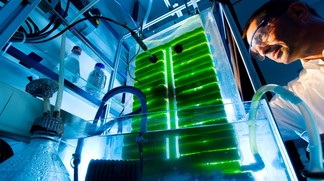Oct 9 2012
Technology developed at EPFL and the Paul Scherrer Institute to transform microorganisms into methane gas will be presented at the Swiss Energy and Climate Summit taking place this week in Bern. The technology could play a role in the future sustainable production of biosynthetic natural gas.
 This demonstration photobioreactor is being shown in Bern. © Subitec
This demonstration photobioreactor is being shown in Bern. © Subitec
A greenish light emanates from a curious structure that has been installed in a pavilion on the Federal Square in Bern. As part of the Swiss Energy and Climate Summit taking place this week, the demonstration bioreactor illustrates a particularly promising technology for synthetic natural gas production developed by Christian Ludwig and his team from the Paul Scherrer Institue and EPFL.
These new “powerplants” have many advantages. “Growing algae consume CO2 from the atmosphere,” Ludwig explains in his presentation, which is scheduled for this Friday in Bern. “As it transforms, it re-emits the CO2 but in a concentrated form that we might be able to sequester and store, for example, underground. This system also produces renewable biogas, thus avoiding the problem of competition with food crops.”
Algae have one notable advantage over other sources of biomass: they “grow” much more rapidly. In favorable conditions, they can generate 30-55 tons of dry matter per hectare per year – five to ten times more than sources such as corn, soy, or sugar cane. “And above all, they can be cultivated without soil, simply in bioreactors exposed to sunlight, thus avoiding the use of fertile croplands that are needed for food production,” Ludwig adds.
In closed circuit
The process presented this week, which goes by the name SunCHem, transforms the algal biomass into methane via catalytic hydrothermal gasification. “This device doesn’t require any solvents and can use non-potable water,” adds Mariluz Bagnoud, a scientist from EFPL’s Environmental Engineering Institute. “In addition, the nutritive elements the algae need, such as phosphorus, are recycled in the process and re-injected into the culture medium. It is an important breakthrough because these resources are limited, too.”
Although the environmental impact is thus minimal, the yield is enormous: 60-70% of the potential energy of the biomass produced in these “photo-bioreactors” can be recuperated in the form of natural gas, with all the advantages that this represents in terms of transport and use – it can simply be injected into an existing gas distribution network. “We have examined the entire length of the chain, from the choice of algae type and how it’s cultured to its transformation into natural gas, in order to identify the best solutions at every stage,” explains Ludwig. “We’re currently working on the regeneration of our ruthenium-based catalyzer.”
Biosynthetic natural gas will play an important role in the energy supply in coming decades. Switzerland will depend on its natural gas power plants as it enters a transitional phase of abandoning nuclear power. “A sustainable and decentralized production of biogas that doesn’t require the use of land necessary for food production has many advantages that we should now be exploiting,” concludes Ludwig.